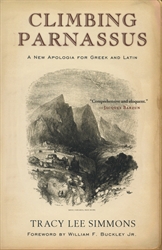If you have put any thought at all into the various approaches to education, classical education has likely cropped up as a possibility. Depending upon which version or versions of it to which you have exposed, as well as your own thoughts about the purpose of education, you might think it appealing, appalling, or something in between.
If you want to understand why classical education has gone through periodic resurgences through the centuries in contrast to most other approaches, you ought to read Climbing Parnassus. Tracy Simmons has written an apologia for classical education that makes sound arguments in its favor. At the same time, Simmons’ eloquent writing that springs from his own classical training is evidence itself of its effectiveness.
Simmons makes a clear distinction between the purpose of education seen through a classical lens—that of forming the character and virtues of a person—and the primarily utilitarian view held by most people. He comments: “School ought to be a training ground for the intellect, not a clearinghouse for “skills”… (p. 242). Elsewhere he writes, “We need to describe the ideal type of human being we wish to see around us. Do we wish merely to produce better skilled, smoothly cut cogs in the elaborate machine we now call the ‘global economy’? Have we finally determined that supertolerant neighbors and sexually adept, flawless drivers are all we can hope to be? Is this the juncture to which 3,000 years of civilized life have brought us?” (pp. 10-11).
Simmons specifies the general form of classical education and its essential components. This is not an easy form of education, but rather one that challenges students to think hard and work hard. Latin is foundational with Greek a close second. Learning these languages is an essential part of the formational process, rather than a subjective choice among a plethora of foreign language options. According to Simmons, students should be proficient enough in Greek and Latin to read some of the most important works ever written in their original languages. While classical education is a great books approach, the ideal is to read as many of those great books as possible in the original language rather than in a translation. Simmons is also a realist, granting that today we do well to teach Latin, even if we cannot also get through Greek.
Latin, Greek, mathematics, and geography would comprise his core subjects if he could dictate the curriculum up through eighth grade. Competence in English reading and writing flows naturally out of the study of Latin and Greek. Simmons doesn’t discuss beginning reading instruction, but I expect he would grant us leeway to teach beginning reading in English before tackling Latin. (If anyone has a different understanding regarding this, please let me know.)
Climbing Parnassus is both inspiring and challenging. Simmons’ contention is that if we no longer provide a classical education to our best and brightest we risk the loss of our culture. It seems fairly evident that we are already well down that path. We’ve witnessed a resurgence of classical education among home educators as well as in new schools created expressly for that purpose. However, even among those who claim to be presenting a classical education, many have strayed rather far from the rigorous approach Simmons advocates.
While it might sound intimidating, the goal is formation of the whole person. Classical education challenges students to think about the ideal and the true; to elevate the mind and the heart; to understand the difference between wisdom and knowledge; and to study and learn from the lessons of history.
“Classical education, properly conducted, works on the principle of Indirection. What we achieve concretely is not as vital to our minds over the long haul as what we’re given the power to achieve—on our own. That’s what formation is all about. We gain independence. Much there is to be said for any curriculum that doesn’t strive to give content so much as it does the tools of skill and judgment that allow us to get that content at our own leisure” (p.230).
I had heard high praise for Climbing Parnassus, but it took me a few years to get around to reading it. I regret that I waited that long!









